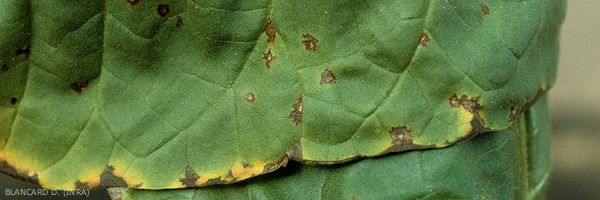
Pseudomonas syringae pv. tabaci
Wolf & Foster (1917) Young, Dye & Wilkie (1978)
Wild fire, Angular leaf spot
- classification : Gammaproteobacteria, Pseudomonadales, Pseudomonaceae
In the past, Pseudomonas syringae pv.tabaci and Pseudomonas syringae pv. angulata were bacteria belonging to Pseudomonaceae (figure 1), which had many biological, but also biochemical properties in common. They are now considered one, single bacterium, called Pseudomonas syringae pv. tabaci. Pseudomonas syringae pv. angulata is actually a strain of Pseudomonas syringae pv. tabaci which does not produce tabtoxine. As you will see later, the different sources of resistance allow to distinguish those strains, which does not clarify the situation.
These two bacteria, with similar symptoms on tobacco leaves, have been observed for decades in many countries on all continents. Currently, their impact on this plant is very serious in some countries such as Malawi, Zimbabwe, Brazil and Thailand. In other countries, their attacks are more or less severe, but sometimes may become very damaging
Although widely spread in Europe, they are not of a significant threat. In France Pseudomonas syringae pv. tabaci seems to have almost disappeared. Over the last five years, it has been isolated and identified only once.
In the past, Pseudomonas syringae pv.tabaci and Pseudomonas syringae pv. angulata were bacteria belonging to Pseudomonaceae (figure 1), which had many biological, but also biochemical properties in common. They are now considered one, single bacterium, called Pseudomonas syringae pv. tabaci. Pseudomonas syringae pv. angulata is actually a strain of Pseudomonas syringae pv. tabaci which does not produce tabtoxine. As you will see later, the different sources of resistance allow to distinguish those strains, which does not clarify the situation.
These two bacteria, with similar symptoms on tobacco leaves, have been observed for decades in many countries on all continents. Currently, their impact on this plant is very serious in some countries such as Malawi, Zimbabwe, Brazil and Thailand. In other countries, their attacks are more or less severe, but sometimes may become very damaging
Although widely spread in Europe, they are not of a significant threat. In France Pseudomonas syringae pv. tabaci seems to have almost disappeared. Over the last five years, it has been isolated and identified only once.





